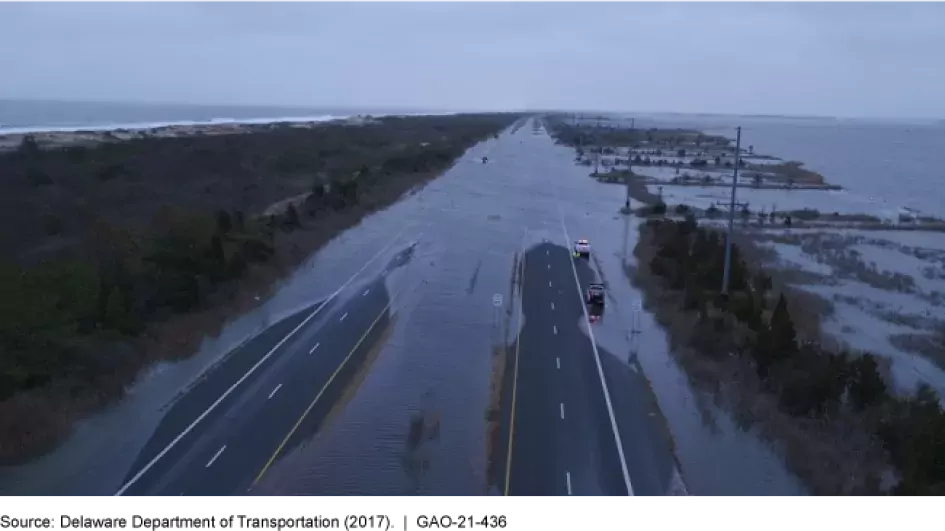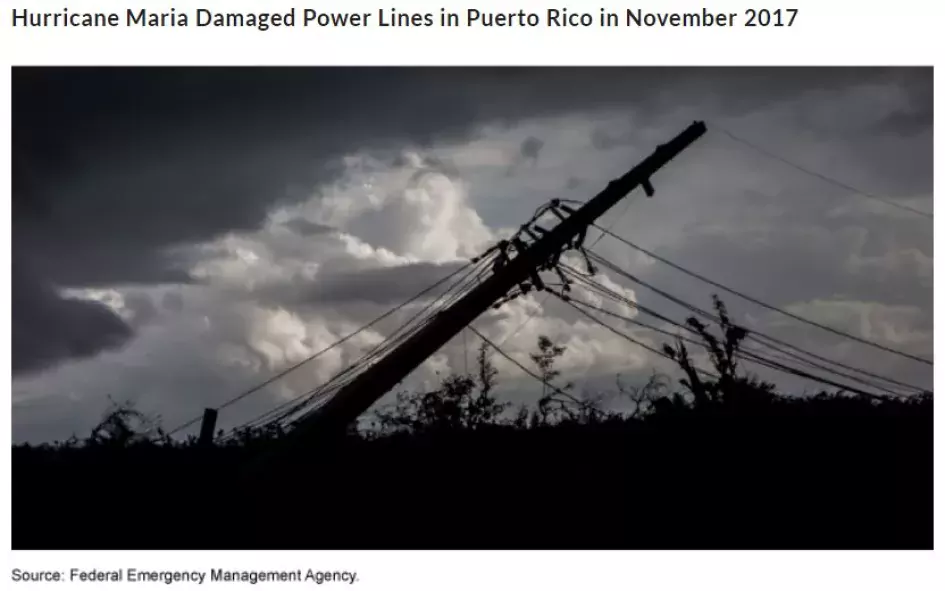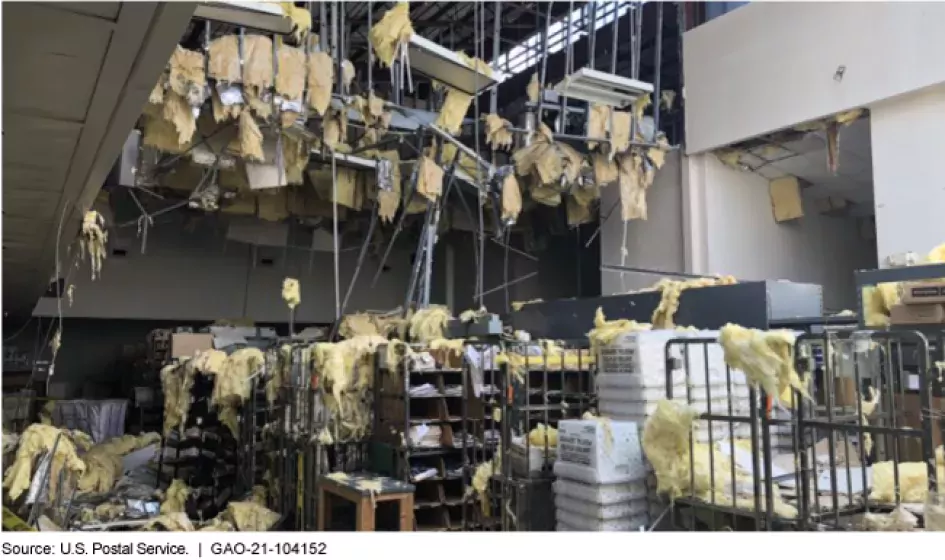How is the Federal Government Approaching Climate Resilience?
Extreme weather events—like wildfires, hurricanes, and some winter storms—threaten the stability of critical infrastructure that we rely on every day. This includes systems like roads, electric grids, supply chains, as well as how this infrastructure is used for military operations. The projected impact of climate change on these critical infrastructures is a key source of federal fiscal exposure because of the size of the federal government’s investment and states’ increasing reliance on the federal government for disaster assistance.
This past year may go on record as one of the most active and costly years for extreme weather events. As of Oct. 8, there have been 18 such events, each with losses exceeding $1 billion, according to the National Centers for Environmental Information. Disaster costs are projected to increase as certain extreme weather events become more frequent and intense due to climate change—as observed and projected by the U.S. Global Change Research Program and the National Academies of Sciences, Engineering, and Medicine.
One way to reduce long-term risk to people and property from natural hazards is to enhance climate resilience. Enhancing climate resilience means taking actions to reduce potential future losses by planning and preparing for potential climate hazards, such as extreme rainfall, sea level rise, and drought. The Administration is taking some actions through various climate-related Executive Orders, and we are monitoring implementation of these emerging efforts.
As our climate continues to change, experts say this trend of larger, more costly weather events will also continue. Today’s WatchBlog post looks at some of our work on federal climate-resilience activities.
Climate-resilient public infrastructure
Every year, the federal government spends billions of dollars to maintain buildings, levees, and roads. This cost could grow as certain weather-related events that cause damage increase in frequency and intensity.
For instance, if roads are flooded from dangerous amounts of rainfall or hurricanes, routes used for emergency evacuations can become unsafe and require costly repairs. Road damage due to climate-related changes may even cost up to $20 billion annually by the end of the century, according to the 2018 Fourth National Climate Assessment.
Flooding on Delaware State Route 1
Image

Over the last decade, the Federal Highway Administration (FHWA), which is part of the Department of Transportation (DOT), has developed policies, provided technical assistance, and funded climate-resilience research as part of its efforts to address climate change's impacts on roadways.
In our September report we found that some states were planning, or already made, changes to their infrastructure using FHWA resources. For example, in Maryland authorities raised a bridge by two feet in anticipation of rising sea levels. While some improvements have been made, more can be done to enhance the climate resiliency of federally funded roads. We identified 10 options for DOT to consider. For example, DOT could provide information to states on best practices and how to include climate projections into road planning and design.
DOT agreed to consider our options when prioritizing climate-resilience actions.
Climate-resilient electricity grid
Severe weather is also expected to impact nearly every aspect of the electricity grid—including the generation, transmission, distribution, and demand for electricity. Extreme-weather events could cost billions—from power outages to infrastructure damage—and leave people without access to electricity.
In February 2021, dangerously cold weather spread into Texas causing increased demand for electricity, and about 4.5 million people lost power.
In August 2021, Hurricane Ida resulted in at least a million people, across three states, without electricity and left seven people dead.
How can we better protect the electricity grid?
Image

Although private companies own much of the electricity grid, the federal government is a key player in promoting its resiliency. Since 2014 the Department of Energy (DOE) and the Federal Energy Regulatory Commission (FERC) have taken steps to improve grid resilience, such as partnering with utilities and collecting information on weather-related risks to grid operations. However, DOE still doesn’t have an overall strategy to guide its climate-resiliency efforts despite recognizing the risks. Additionally, FERC hasn’t identified or assessed weather-related risks to the grid.
In a March 2021 report, we recommended that DOE develop a department-wide strategy to enhance grid resilience, and FERC identify and asses risks to the grid and plan a response.
Climate-resilient federal properties
USPS. The U.S. Postal Service (USPS) is an essential means of communication and commerce for millions of Americans. It has over 32,000 facilities nationwide. Severe weather damage to these facilities could delay mail delivery and other services.
From FY 2015 through 2019, extreme weather damage to USPS facilities resulted in more than $30 million in repair costs.
And in a September report, we found that over 10,000 of the USPS’s facilities (about one-third) are in geographic areas susceptible to weather-related events, such as flooding or wildfires.
Hurricane Michael damaged ceilings at a post office in Lynn Haven, Florida, October 2018
Image

In response to climate-related threats, the USPS has added resilience requirements to its facility guidance and is using a mapping tool to analyze climate data during the facility investment process. However, we found that USPS isn’t incorporating these data at the preliminary planning stages for facility investments—like repairs or new construction—per its own policy. We recommended that they do so. USPS agreed with our recommendation and is reevaluating its facility investment process.
DOD. Department of Defense (DOD) installations provide services and support to servicemembers and their families, and are critical for maintaining military readiness. DOD global property holdings are worth nearly $1.2 trillion. In 2019, we reviewed DOD’s efforts to incorporate climate resilience into installation facilities across the department’s portfolio. We found that DOD had not analyzed future vulnerabilities to climate change, and instead relied only on past weather experiences. We also found that DOD had no guidance on how to incorporate climate projections in new construction designs. We recommended that they develop this, along with seven other recommendations. DOD agreed with and implemented our recommendations.
Additionally, we identified risks to DOD’s facilities overseas in a separate report. In December 2017, we reported that climate change poses operational and budgetary risks to DOD’s overseas infrastructure. While the military services had begun to integrate climate change adaptation into installation plans and project designs, they were not consistently providing information to installation planners and engineers on climate change adaptation. As a result, some of DOD’s overseas installations weren’t well positioned to respond to climate-related risks, which could impact the military’s readiness. We recommended that the military services incorporate climate change adaptation into service-level guidance and required training, along with 11 other recommendations for DOD to improve their incorporation of climate adaptation into planning overseas installations. DOD has taken steps to implement some of our recommendations, but needs to do more to implement all of them.
Climate-resilient supply chains
Climate change is also projected to have broad effects that could impact the stability and management of our nation’s supply chains, including those used by DOD. For example, flooding can damage roads or electrical infrastructure—delaying the arrival of critical supplies or services, including information technology, to military installations.
In 2020, we reported that DOD’s acquisition and supply chain processes include steps to plan for future sustainment and consider potential disruptions, but don’t consider climate-related risks. We made 6 recommendations, including that DOD should incorporate climate resilience into military acquisition and supply guidance.
Want to learn more about our work about the federal government and climate resilience? Visit our High Risk Area page focused on better managing climate change risks.
- Comments on GAO’s WatchBlog? Contact blog@gao.gov.





